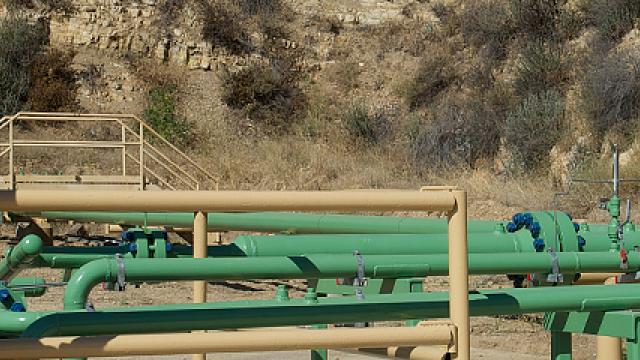Latest News
Final Results of Investigation into October 2019 Small Fire
In October 2019, the Saddleridge Fire passed through a portion of the Aliso Canyon natural gas storage facility. There was no damage to SoCalGas’ natural gas infrastructure at the facility. Following this fire, a small spot fire was discovered on a steep hillside and was extinguished by the Los Angeles County Fire Department. SoCalGas undertook an extensive, nearly year-long investigation into the cause of this spot fire. The investigation was conducted by a third party and with the involvement of several agencies, including, CalGEM, the California Public Utilities Commission, South Coast AQMD, Los Angeles County Fire Health Hazmat Department, Los Angeles County Department of Public Health, and California Air Resources Board.
The investigation included air and soil sampling, an isotopic analysis of gas at the site, monitoring and reporting, excavations in the area around the location of the small spot fire, a review of certain infrastructure within a quarter mile of the small spot fire location, historical aerial photography review, and geophysical and site surveys.
Based on the results of the studies performed during the investigation, the source of the spot fire was determined to be a natural sub-surface seep and not storage gas. Naturally occurring oil and gas seeps are prevalent in areas of California near oil and gas reservoirs. One famous example is the La Brea Tar Pits in Los Angeles.
With the investigation now concluded, SoCalGas will begin restoring the areas where investigation activities were performed. This will include backfilling any open excavations and stabilizing the disturbed area. We will also monitor site conditions during the upcoming rainy season.
SoCalGas has shared these findings with the relevant agencies.
Ongoing Site Investigations and Air Sampling - July 16, 2020
Following the October 2019 Saddleridge Fire, an area of low-level surface emissions was discovered in the immediate area of a small fire which had ignited during the Saddleridge Fire. The small fire was quickly extinguished, and since that time SoCalGas has continued to investigate the source of low-level surface emissions.
With oversight from local and state agencies, SoCalGas has been carrying out field activities and sampling efforts to identify and monitor the fuel source. An isotopic analysis confirmed that the low-level surface emissions are not consistent with natural gas contained within the geological zones used for natural gas storage.
These efforts also include an estimate of the amount of methane gas being emitted from the area. The low-level surface emissions area was estimated to be releasing about 2,000 kg of methane per year, or about 5.5 kg per day, at the time. The estimated annual emissions from the area are about the same amount of greenhouse gas emissions 11 passenger cars emit in a year.
Throughout the investigative process, SoCalGas has continued to monitor air and soil data. This monitoring confirms that the low-level emissions are observed only in the immediate area and not other areas of the Aliso Canyon facility or nearby communities.
Based on all SoCalGas and agency sampling to date, there is no risk to community health or safety for workers on the site or the community.
Ongoing Site Investigations and Air Sampling - June 11, 2020
Over the last several months, with oversight from local and state agencies, SoCalGas has been undertaking significant field activities and sampling efforts to identify the fuel source of a small fire that was extinguished following the Saddleridge Fire. To date, SoCalGas has undertaken extensive isotopic analysis to evaluate the composition of the low-level methane emissions. This analysis has confirmed that the emissions are not consistent with natural gas contained within the geological zones used for natural gas storage.
SoCalGas remains engaged in ongoing ambient air sampling and is undertaking significant excavation activities along the steep hillside area to aid in identifying the emissions source. Additionally, local agencies have overseen and also conducted air sampling at the site. SoCalGas currently anticipates continuing its investigative work through July while submitting a final summary report to the overseeing agencies in August.
Throughout the investigative process, SoCalGas continues to monitor air and soil data. This monitoring indicates that the low-level emissions are only observed in the immediately impacted area and not in other areas of the Aliso Canyon facility or nearby communities.
Based on all SoCalGas and agency sampling to date, there is no risk to community health or safety for workers on the site or the community.
12/4/19 - Saddleridge Fire
- SoCalGas continues to work in cooperation with state and local agencies, to investigate the extent of the impacted soil observed at the area of the small fire that was extinguished on Oct. 15, 2019.
- Air and soil detections continue to indicate that the low-level emissions are being detected only at the immediate area of the extinguished small fire. The emissions are not reaching other areas of the Aliso Canyon facility nor any nearby communities.
- Based on all SoCalGas and agency sampling to date, there is no risk to community health or safety for workers on the site or the community.
- SoCalGas will continue to keep the multi-agency oversight group informed of its activities and findings relating to the fire-impacted area.
5/17/19 - SoCalGas Issues Statement on Blade’s Analysis of Aliso Canyon Well Failure
Earlier today, Blade Energy Partners (Blade) published a report detailing its analysis of the 2015 natural gas leak at SoCalGas’ Aliso Canyon storage facility. The investigation was conducted at the direction of the California Public Utilities Commission and the Division of Oil, Gas and Geothermal Resources.
The report concluded that a rupture in the outer casing of the well occurred on the morning of October 23, 2015, followed hours later by a complete separation of the casing. According to the report, microbial induced corrosion caused the metal in the outer casing to thin, which led to the rupture.
Blade’s report confirms SoCalGas complied with gas storage regulations in existence at the time of the leak. Blade also determined that SoCalGas’ current practices and new state regulations address most, if not all, of the causes identified in the report. SoCalGas is still reviewing the report and issued the following media statement in response to the report’s release:
“The release of this report marks an important milestone in helping the region and California move forward from the Aliso Canyon natural gas leak. The leak was an industry changing event resulting in the development and implementation of enhanced safety regulations and practices.
“Today Aliso Canyon is safe to operate and Blade’s report indicates the industry leading safety enhancements and new regulations put in place after the leak should prevent this type of incident from occurring again."
SoCalGas’ full statement can be found here.
To view Blade's full report click here.
The Importance of Aliso Canyon
Aliso Canyon serves more than 11 million customers and provides fuel to 17 natural gas-fired power plants. It is a critical part of the region’s energy infrastructure – more than 90 percent of Southern Californians depend on gas for heat and hot water, and approximately 60 percent of all the electricity generated in California is made by natural gas-fired power plants. Natural gas storage is especially important for electric generation because it supports renewable power sources, like wind and solar, and allows us to avoid burning dirty fuels, like diesel or coal, to keep the lights on. When the wind doesn’t blow or the sun doesn’t shine for renewable electric generators, the natural gas from Aliso Canyon helps to fill those energy gaps.
Aliso Canyon is centrally located in the Santa Susana Mountains, allowing for a quick and effective response to local, real-time energy demands. The location of the field is important because, unlike electricity, natural gas typically travels at relatively slow speeds in the range of 20-30 miles per hour. For example, it could take approximately ten hours for natural gas supplies to travel through SoCalGas’ transmission system from Blythe to several power plants located in the Los Angeles basin. By contrast, natural gas withdrawn from Aliso Canyon can meet demand significantly quicker, within one to two hours. Natural gas storage allows both large and small customers to enjoy a consistent supply of natural gas to heat their homes, to cook their food, and to power their businesses, twenty-four hours a day, seven days a week.
Our Commitment to Safety
In support of continued safety, Aliso Canyon is being held to the most rigorous monitoring, inspection and safety requirements in the nation. Ongoing steps to maintain accountability include:
- Testing or abandonment of wells that remain temporarily plugged;
- Real-time pressure monitoring of all wells;
- Visual inspections of each well four times a day;
- Daily infrared thermal imaging scanning of each well to detect leaks;
- Operation of the fence line methane monitoring system; and
- Community engagement through the Community Advisory Council.
Well Inspection Update
We continue to work with CalGEM and CPUC to complete a comprehensive safety review of all wells at Aliso Canyon. On the first and third Friday of every month, SoCalGas provides CalGEM with an updated well inspection report.
As of March 10, 2020:
- 114 (or 100 percent) of the active wells at Aliso Canyon have completed the first phase of required tests;
- Number of wells with all tests completed – 66
- Number of wells plugged and abandoned – 21
- Number of wells in the process of abandonment – 27
Well inspection test results are posted on CalGEM's website and can be found here.
More on Infrastructure, Technology, and Safety Enhancements
SoCalGas has worked diligently to complete what experts have called “the most comprehensive safety review in the country,” creating multiple layers of safety at Aliso Canyon. Work we have completed includes:
- Replacing the inner steel tubing of every approved well;
- Using the casing around the new inner steel tubing — tested to ensure integrity under pressure — to provide a physical, secondary barrier of protection against potential leaks;
- Operating the facility at reduced pressure, as directed by CPUC;
- Withdrawing and injecting natural gas only through the inner steel tubing of those wells that have passed all tests and have been approved for use by CalGEM.
We have also introduced a suite of advanced leak-detection technologies and practices that allow for early detection of leaks and help quickly identify anomalies, such as changes in well pressure. These enhancements include:
- Continuous ambient methane monitoring systems;
- An infrared fence-line methane detection system with eight pairs of infrared methane monitors;
- Around-the-clock monitoring of the pressure in all wells from our 24-hour operations center;
- Twice-daily patrols to visually examine every well;
- Enhanced training for our employees and contractors.
- A summary of the changes at each well at Aliso Canyon is available as a PDF.

